Abstract
Intangible cultural heritage (ICH) constitutes a vital component of cultural diversity and a defining element of regional identity. Understanding its spatial patterns and determinants is fundamental to informing robust conservation strategies and ensuring its continuity across generations. This research employs kernel density analysis, average nearest neighbor analysis, and Poisson regression to examine the spatial distribution patterns and determinants of 3576 national, provincial, and municipal ICH items across 21 prefecture-level cities in Guangdong Province, China. The research results show the following: (1) All ICH categories in Guangdong province exhibit a significant spatial clustering, with Quyi (Chinese folk performing arts) demonstrating the most pronounced agglomeration, followed by traditional opera and traditional music. (2) Kernel density estimates display pronounced hotspots in the Guangzhou–Foshan core of the Pearl River Delta (PRD) and in Eastern Guangdong’s Chaozhou–Shantou corridor, while each heritage category displays its own geographically distinct footprint. (3) From the perspective of natural factors, ICH items are predominantly located in areas characterized by flat topography, proximity to rivers, and a mild subtropical climate, notably the coastal regions of the PRD, Eastern Guangdong, and Western Guangdong. These areas also possess superior resource endowments and transportation infrastructure. (4) Regarding socioeconomic factors, the analysis results point out distinct socioeconomic influences. Specifically, a larger registered population and higher per capita Gross Domestic Product (GDP) correspond to more ICH items. However, two factors demonstrate negative relationships: the total resident population and the level of dialect diversity. This study systematically elucidates the spatial distribution characteristics of ICH in Guangdong Province and their key influencing factors. The outcomes offer critical empirical evidence, thereby informing the design and implementation of optimized ICH conservation measures, promoting coordinated regional cultural development, and achieving the sustainable utilization of ICH resources.
1. Introduction
The significance of Intangible Cultural Heritage(ICH) lies in its role as both a vital embodiment of cultural diversity and a measure of a nation’s or ethnic group’s overall competitiveness []. As a vital component of human civilization, ICH embodies the cultural consciousness and identity of the Chinese nation []. As defined by United Nations Educational, Scientific and Cultural Organization (UNESCO)’s Convention for the Safeguarding of the Intangible Cultural Heritage (2003), ICH encompasses the practices, representations, expressions, knowledge, techniques—together with the instruments, objects, artifacts and cultural venues related to them—that communities, groups and, in certain instances, individuals acknowledge as constituting their cultural legacy []. This definition establishes a common foundation for ICH safeguarding efforts worldwide. China’s 2021–2025 National ICH Safeguarding Plan, released in 2021, has set the strategic road-map for protecting and transmitting ICH across the country []. With the growing global emphasis on ICH protection and transmission, the characteristics of its spatial distribution and the factors influencing it have become a key research focus in recent years. Safeguarding efforts center on sustaining the living continuation of ICH by systematically identifying, recording, studying, conserving, shielding, fostering, enriching, disseminating—especially via formal and informal education—and re-energizing its diverse dimensions (UNESCO, 2003) []. This provides the theoretical basis for this study to explore the spatial factors influencing the dissemination and promotion of ICH [].
Wulf (2016) proposed that ICH can be understood through five structural dimensions: the human body, performativity, ritualistic ‘representation,’ imitative transmission mechanisms, and its social function in fostering cultural diversity and the integration of otherness []. Menzel (2016) emphasized ICH as a form of living cultural memory, whose theoretical basis can be traced back to Halbwachs’ concept of collective memory [], highlighting the core role of ICH in maintaining group identity and historical continuity. De Oliveira Pinto (2016) further situated ICH practices within the interaction of three cultural levels: “fact,” “act,” and “artifact” []. These dimensions are profoundly shaped by local natural endowments (e.g., topography, rivers) and socioeconomic conditions (e.g., economic level, demographic structure).
Currently, research on ICH by scholars domestically and internationally has evolved from early perspectives rooted in folklore, ethnology, cultural studies, tourism economics, and geography [], with a focus on conceptual connotations [], characteristic summarization [], and pathways for protection and inheritance []. From the geographical perspective, the relevant studies have progressively shifted toward employing quantitative analysis to examine how natural conditions and socioeconomic forces shape the spatial configuration of ICH.
From a geographical perspective, the focus of research on ICH is mainly on its spatiotemporal distribution patterns [,,,], influencing factors [], and its constraining relation with the spatial distribution of traditional ancient villages []. Methodologically, studies have largely centered on a standard suite of spatial analysis tools such as kernel density analysis, nearest neighbor index, and geographical detectors [,,,,] to describe the spatial patterns of ICH. Some studies indicate that ICH location is shaped not only by economy and policy, but also history [,]. For instance, Zhang et al. (2022) demonstrate that the spatial distribution of ICH resources in China is uneven and clustered, with social factors having a greater impact than natural factors, and multidimensional interactions significantly affecting the spatial pattern []. Nie et al. (2022) utilized ArcGIS spatial analysis and geographical detectors to conclude that there are strong province gaps in Yellow River ICH, with road density, Gross Domestic Product (GDP), population density, urbanization level, as well as water systems and topography influencing its spatial distribution []. Wang et al. (2023) observed that the spatiotemporal pattern of ICH across the Yangtze River Basin is shaped chiefly by human and social elements, with natural geographical and policy factors playing secondary roles []. In terms of ICH preservation and development strategies, some studies have highlighted the indispensable role of policy guidance []. Some studies have focused on the tourism development potential of ICH resources, such as Jiang et al. (2019), who proposed a tourism development model of “core-peripheral areas + two-wing regions” using Chongqing as a case study []. Cutting-edge digital tools, notably Geographic Information System (GIS), big data analytic, and AI, are now empowering the investigation and preservation of ICH research, bringing innovations to traditional methodologies. For example, Zhang & Yuan (2023) harnessed large-scale datasets to map the spatio-temporal evolution of ICH and probe how scenic sites react to its shifting distribution [].
Guangdong traditional culture, belonging to the Lingnan culture, boasts rich regional ICH resources with unique cultural charm and enduring vitality. Guangdong is the forerunner of China’s reform and opening up. As the most economically productive province, Guangdong is home to a distinctive cultural mosaic shaped by the interplay of its many sub-ethnic groups (e.g., Cantonese, Hakka, Teochew, Leizhou) and ethnic cultures (e.g., Yao culture, She culture). It boasts a number of ICH items ranking among the highest nationally. Furthermore, serving as an essential node of the Maritime Silk Road and a vital window for the international dissemination of outstanding traditional Chinese culture, Guangdong exhibits significant representativeness and exemplary value for this study. Yet, inquiries into how ICH items are spatially distributed across Guangdong—and what drives these patterns—remain limited. Among the few exceptions, Yuan & Chen (2012) mapped 463 documented heritage items, examining their administrative tiers, typologies, geographic spread, and links to river networks []. However, the findings possess certain limitations. In the current classification framework for ICH projects, China has established a four-tiered hierarchy of ICH lists at the national, provincial, municipal, and county levels. Drawing on a December 2024 inventory of 3576 national-, provincial-, and municipal-level ICH entries (including extension items), this study offers a systematic portrait of their spatial arrangement and driving forces across Guangdong’s 21 prefecture-level cities. By filling a recognized research gap, the findings provide an evidence-based foundation for safeguarding heritage in diverse forms and for steering the province toward high-quality, sustainable growth (conceptual framework shown in Figure 1)
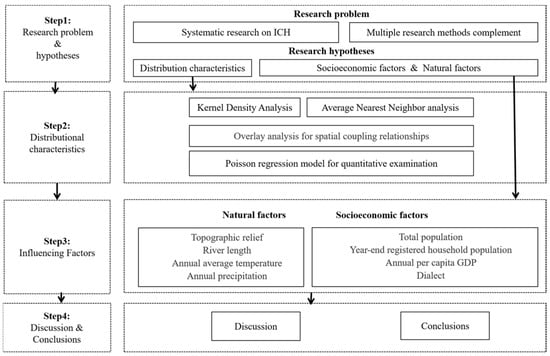
Figure 1.
The research model for ICH items of Guangdong Province. Designed and made by the author.
This investigation seeks to elucidate the spatial distribution and formative mechanisms of ICH in Guangdong Province through a systematic examination, encompassing both natural and socioeconomic dimensions. The ultimate goal is to propose targeted strategies for the precise preservation and promotion of ICH. Consequently, the research framework is structured as follows: First, kernel density estimation and average nearest neighbor analysis are employed to measure the spatial density, aggregation level, and regional disparities of different ICH categories. Second, overlay analysis is applied to reveal the spatial coupling relationships between natural and socioeconomic factors and ICH distribution. Third, a Poisson regression model is constructed to quantitatively examine the intensity and direction of the impacts of various elements on ICH distribution. Finally, based on the empirical results, zonal and categorized plans for ICH conservation and utilization are formulated.
2. Materials and Methods
2.1. Data Sources
The research data for this paper encompass national, provincial, and municipal ICH items (including formal and expanded projects) across 21 prefecture-level cities (178 counties and districts) within Guangdong Province. Data on nationally designated heritage entries was retrieved from the official portal of China’s Intangible Cultural Heritage (accessed on 15 November 2024) [] totaling 121 items. We obtained the list from the Guangdong Provincial Cultural Center website [] and the official website of Guangdong Provincial People’s Government [], comprising eight batches of provincial representative ICH lists, with a total of 703 items. Municipal ICH data were collected from the officially published municipal representative ICH lists on the government websites of the 21 cities, amounting to 2752 items. Some ICH items share the same names in different multiple locations but with their local characteristics; they are counted as different items, resulting in a total of 3576 items for analysis.
Two primary classification systems exist for categorizing ICH items. The first one is the five-category framework adopted by UNESCO on the Convention for the Safeguarding of the Intangible Cultural Heritage, which includes performing arts; traditional craftsmanship; oral traditions and expressions; social practices; rituals and festive events; and knowledge and practices concerning nature and the universe []. The second one is the ten-category system established under the Law of the People’s Republic of China on Intangible Cultural Heritage, used for the National Representative List of ICH, comprising traditional craftsmanship; traditional fine arts; traditional sports, recreation and acrobatics; traditional dance; traditional opera; traditional medicine; traditional music; folk literature; folk customs; and Quyi []. This study adopts the ten-category system for its analysis.
We set each ICH item on the map at the center point of its county or district. The points come from autonavi map (AMAP). Borders come from China’s standard vector map GS(2020)4619. Utilizing ArcGIS 10.6 as the technical platform, a spatial attribute database for Guangdong’s ICH was constructed, and a spatial distribution map of the ICH items was generated.
Furthermore, data for the research area, including Digital Elevation Model (DEM) (topographic relief), river length, annual average temperature, and annual precipitation, were sourced from the 90m resolution sub-prefectural DEM data (SRTM90m) provided by the Resource and Environment Data Platform of the Chinese Academy of Sciences []. Socioeconomic data, such as total population, year-end registered household population, annual per capita GDP, and dialect information, were primarily obtained from the Guangdong Provincial Archives Database [], specifically from the 2023 yearbooks of the districts and counties under the 21 prefecture-level cities. To ensure data accuracy, these figures were meticulously verified against relevant data published in the “2022 Statistical Communiqués on National Economic and Social Development” of the respective cities, districts, and counties, as released by the governments of the 21 prefecture-level cities.
2.2. Research Methods
2.2.1. Kernel Density Analysis
Kernel density estimation (KDE) [] is a non-parametric method used to estimate the density function of spatial point agglomeration []. It is suitable for generating a two-dimensional smoothed estimation surface that describes the clustering intensity of observed variables, producing a spatially continuous density variation layer that reveals “peaks” and “troughs” []. In this study, the locations of ICH items in Guangdong Province were abstracted as point features on a vector map using the coordinates of their protection units (or, if unclear, the administrative centers of their respective regions). Kernel density analysis was applied to conduct hotspot analysis. A higher kernel density value indicates a more concentrated spatial distribution of ICH items, while a lower value suggests a more dispersed distribution. The formula is as follows:
where
- Pi is the estimated density value at any point i in space.
- n is the total number of Point of InterestS (POIs) within the bandwidth.
- Kj is the weight of the study object at point j.
- Dij is the distance between point i and point j.
This study employed Silverman’s Rule of Thumb to calculate and determine the optimal bandwidth h. This method calculates the optimal threshold for h based on the spatial distribution of the data itself, by determining the average distance between all points and the median of these distances Dm, and the standard distance SD. The calculation formula is as follows:
where
- SD is the standard distance.
- Dm is the median distance.
The min function in the equation indicates that the smaller value calculated from the two options will be used.
Once the bandwidth h is determined, it can be substituted into Equation (1) to calculate the estimated density value.
2.2.2. Average Nearest Neighbor Analysis (ANN)
The average nearest neighbor index (ANNI) measures the degree of clustering or dispersion of point features in space. Taking the ICH points in space as the objects of study, it compares the observed average distance between each point and its nearest neighbor (Obs.D) to the expected average distance if the points were randomly distributed (Random.D). If Obs.D < Random.D, the spatial distribution of the analyzed ICH points is considered clustered; otherwise, it is considered dispersed. The average nearest neighbor ratio is derived by dividing the observed mean distance between points by the expected mean distance for a random distribution. Values below 1 signify clustering, whereas values above 1 denote dispersion []. The formula is as follows:
where
- is the observed mean distance between each ICH POI and its nearest neighbor.
- is the expected mean distance for a random distribution of such POIs.
If ANN < 1, the distribution pattern of the POIs is clustered. If ANN ≥ 1, the distribution pattern is dispersed.
2.2.3. Poisson Regression Analysis
The factors influencing the spatial distribution of ICH include both nature elements (such as topography, climate, and rivers) and socioeconomic elements (such as economy [], population, and dialect). To analyze the relationship between ICH and these factors, the Focus Statistics tool in ArcGIS 10.6 was used to calculate relief amplitude, and multi-level buffer analysis was performed on rivers. Simultaneously, spatial join was employed to aggregate factors such as topography, climate, economy, and population to each county-level spatial unit. Regression was further applied to test the impact of these indicators on the number of ICH items. The formula is as follows:
The number of ICH items in each county i is denoted as yi (where i = 1, 2, 3, …, 178). The logarithmic function was selected as the link function, where
E(yi) is the expected number of ICH items in the i-th county.
Xik is the observed value of the k-th influencing factor in the i-th region.
is the intercept.
is the regression coefficient for the k-th influencing factor.
3. Results
From the perspective of approval batches (Figure 2a), the largest number of ICH items belongs to the first batch, totaling 512 items and accounting for 14.32% of the total ICH items. This is followed by the seventh batch, with 507 items (14.18%), and the sixth batch, with 477 items (13.34%). Among these, the first batch contributed the highest number of newly added items, while the fourth batch contained the most expanded items.

Figure 2.
The structure characteristics of ICH items of Guangdong Province.
In terms of ICH categories (Figure 2b), traditional craftsmanship has the most items. This is followed by folk customs and traditional dance. The categories with the fewest items are Quyi, traditional opera, folk literature, and traditional medicine, each comprising fewer than 200 items.
Regarding the temporal structure (Figure 2c), the years 2022 and 2007 saw the highest number of ICH items approved, with 489 and 479 items respectively, accounting for 13.67% and 13.39% of the total.
3.1. Spatial Distribution Types
The average nearest neighbor ratio in Table 1 indicates that, overall, the spatial distribution of the total count of ICH items in Guangdong Province, as well as that of the ten sub-categories of ICH, exhibits a significant clustered pattern, with a confidence level as high as 99%. Among them, the Quyi category has the relatively highest average nearest neighbor ratio, indicating the most pronounced degree of agglomeration. The clustered characteristics of traditional opera and traditional music are also relatively significant. In contrast, folk customs and traditional craftsmanship have relatively lower average nearest neighbor ratio, indicating a less concentrated distribution.

Table 1.
Average nearest neighbor ratio.
3.2. Spatial Distribution Characteristics of Different ICH Categories Across Regions
Guangdong Province is regionally divided into four major areas: the Pearl River Delta (PRD), Eastern Guangdong, Western Guangdong, and Northern Guangdong []. The PRD includes nine cities: Guangzhou, Shenzhen, Foshan, Dongguan, Zhongshan, Zhuhai, Zhaoqing, Jiangmen, and Huizhou. Eastern Guangdong comprises four cities: Chaozhou, Shantou, Jieyang, and Shanwei. Western Guangdong includes three cities: Zhanjiang, Maoming, and Yangjiang. Northern Guangdong consists of five cities: Yunfu, Qingyuan, Shaoguan, Heyuan, and Meizhou (administrative division of Guangdong Province shown in Figure 3).
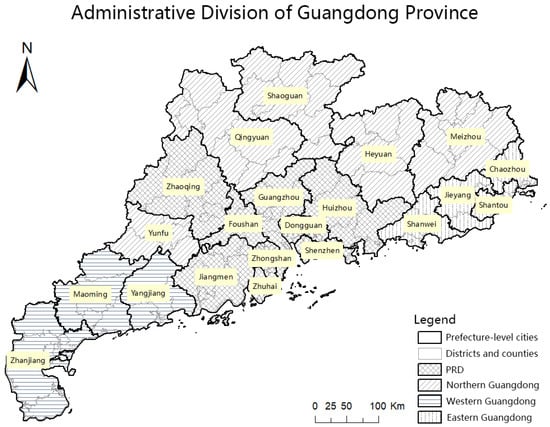
Figure 3.
The administrative division of Guangdong Province.
Overall (shown in Table 2), the PRD, characterized by its long history, economic prosperity, convenient transportation, and dense population, accounts for the largest share of ICH items, reaching 42.37%. Eastern Guangdong follows closely, contributing 22.18% of the total ICH items, owing to its profound historical and cultural heritage. Northern Guangdong accounts for 20.33%, while Western Guangdong has the smallest proportion, at just 15.13%.

Table 2.
The percentage of ICH categories in various regions of Guangdong Province.
Analyzing the distribution of different ICH categories reveals that traditional craftsmanship, traditional sports, recreation, and acrobatics, traditional dance, traditional music, folk literature, folk customs, and Quyi are most concentrated in the PRD and least concentrated in Western Guangdong. Categories such as traditional sports, recreation, and acrobatics, traditional medicine, and Quyi see over half of their items located in the PRD. Traditional fine arts and traditional opera are most prevalent in Eastern Guangdong, while traditional medicine is most distributed in the PRD and least distributed in Northern Guangdong.
3.3. Spatial Heterogeneity of ICH Distribution Based on Kernel Density Analysis
A kernel density analysis was conducted on all ICH items in Guangdong Province, categorizing the core density zones into four levels: high-density, relatively dense, relatively sparse, and sparse zones. As for the amount of ICH items, among the 21 prefecture-level cities in Guangdong, Guangzhou, Jieyang, and Dongguan ranked highest in total ICH items, while Yunfu, Zhuhai, and Zhaoqing had the fewest. The kernel density analysis covered 182 county/districts (excluding Shenzhen’s Guangming District, Zhongshan’s Dongsheng Town, and Dongguan’s Ecological Park due to data unavailability, resulting in 179 valid ones).
The analysis results (shown in Figure 4) reveal significant regional disparities in the distribution of ICH items across Guangdong Province. High-density zones are primarily concentrated in the Guangzhou–Foshan area within the PRD and the Eastern Guangdong region centered on the Chaozhou–Shantou area. These areas boast a time-honored history and deep-rooted cultural legacy, nurturing a remarkable diversity of ICH items. Their developed economies and convenient transportation networks further provide favorable conditions for the protection, transmission, and dissemination of ICH. Relatively dense zones are distributed across the entire PRD, the coastal areas of Eastern Guangdong, and the Yangjiang area in Western Guangdong. These regions, benefiting from coastal locations, also enjoy relatively sound economic foundations and transportation infrastructure, thereby serving as a catalyst for the preservation and evolution of ICH. In contrast, Northern Guangdong, characterized predominantly by mountainous and hilly terrain, faces limitations in the transmission and inheritance of ICH, resulting in relatively scarce ICH resources and significantly lower distribution density.
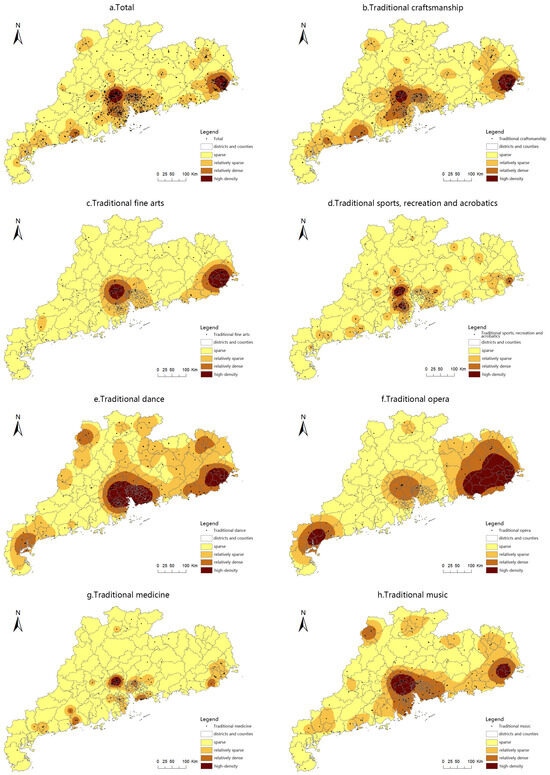
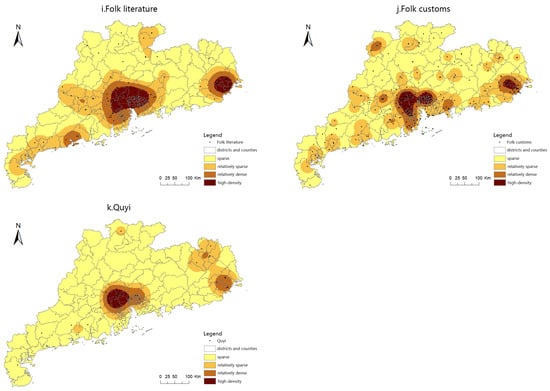
Figure 4.
Kernel density distribution of various categories of ICH in Guangdong Province.
Each category of ICH in Guangdong exhibits distinct regional variations, as detailed below:
Traditional craftsmanship ICH, encompassing handicrafts and manufacturing techniques, relies on master–apprentice or familial transmission, emphasizing technical secrecy and the use of locally distinctive materials. Its high-density zones are primarily concentrated in the PRD and Eastern Guangdong, with small, localized dense areas in Western Guangdong. No high-density zone exists in Northern Guangdong. The PRD, along with Chaozhou and Shantou in Eastern Guangdong, historically served as commercial hubs with deep-rooted artisan traditions, where merchant activity facilitated the commercialization of crafts. Coastal areas in Western Guangdong developed local characteristic crafts leveraging marine resources, but their economic scale limited dense zones to small pockets. The mountainous terrain of Northern Guangdong, with its poor transportation links, lacked the market circulation conditions necessary for traditional crafts, resulting in an absence of high-density zones.
Traditional fine arts ICH shows significant high-density zones in the PRD and Eastern Guangdong, benefiting largely from the prosperous commodity economy in these regions. There is strong local demand for decorative arts within this category, such as architectural painting and ancestral temple carvings, which promotes the transmission and advancement of these ICH items.
Traditional sports, recreation, and acrobatics ICH, characterized by playful, educational, performative, or competitive physical skills and arts, refers to movement arts with distinct ethnic and local features within specific regions. Most items crowd in the PRD and east part of Guangdong.
Traditional music ICH exhibits high-density zones primarily in the PRD and Eastern Guangdong. Additionally, the Zhuang and Yao Autonomous Counties in the northwestern part of Northern Guangdong show a relatively dense distribution due to the abundant traditional music culture of the local ethnic minorities.
Folk literature ICH, comprising oral literary works created and transmitted by the masses through long-term social practice, has high-density zones in the PRD and Eastern Guangdong, with relatively dense areas also found in Western Guangdong.
Folk customs ICH, referring to the customs and festive activities formed and inherited by local people of various ethnic groups and regions through long-term social practice, has high-density zones in the PRD and Eastern Guangdong. Due to its strong regional character, it also shows relatively dense distribution in the northwestern part of Northern Guangdong.
Quyi ICH has high-density zones in the PRD and relatively dense zones in Eastern Guangdong. The economic prosperity and active cultural markets in the PRD and Eastern Guangdong provide a broad public base and market demand for Quyi performance, a deeply popular form of cultural entertainment. For instance, in Cantonese-speaking areas like Guangzhou and Foshan, local people spontaneously organize Yuequ (Cantonese opera singing) art groups known as “Sihuoju” (amateur Cantonese opera singing groups), which regularly perform in streets, alleys, and under large banyan trees or in ancestral temples.
4. Causes of the ICH Distribution Pattern
Both overall and across individual categories, the intangible cultural heritage (ICH) of Guangdong Province exhibits a spatially agglomerated distribution pattern. The high-density and relatively dense zones of its overall distribution are mainly clustered in the PRD and the coastal areas of Eastern and Western Guangdong. In contrast, Northern Guangdong, aside from having relatively dense zones for Traditional Dance, Traditional Music, and Folk Customs, shows a relatively sparse distribution for other ICH categories. This distribution pattern demonstrates a significant coupling with the spatial characteristics of Guangdong’s natural environment (e.g., topography, rivers, and climate) and socioeconomic factors (e.g., economy, ethnicity). This study will analyze the mechanisms influencing the spatial distribution of ICH in Guangdong Province from two aspects: natural environmental factors and socioeconomic factors.
4.1. ICH and Topography
The concentration of Guangdong’s ICH in plain areas is closely related to topography. Flat terrain facilitates human settlement and transportation development, eases communication and interaction among people, and provides better environment for the inheritance and dissemination of ICH. By calculating the topographic relief based on Guangdong’s elevation data, classifying it according to the standards of flat terrain (0–5 m), small relief (5–15 m), medium relief (15–45 m), mountainous relief (45–140 m), and high mountainous relief (>140 m), and overlaying this with the kernel density map of Guangdong’s ICH, it can be observed that the high-density and relatively dense zones of ICH are mainly concentrated in flat terrains, such as the PRD, Chaozhou, and the coastal area of Zhanjiang (illustrated in Figure 5). These regions topographically belong to flat and small relief areas. They are close to the sea, having developed transportation, and dense populations, all of which are conducive to the inheritance and transmission of ICH.
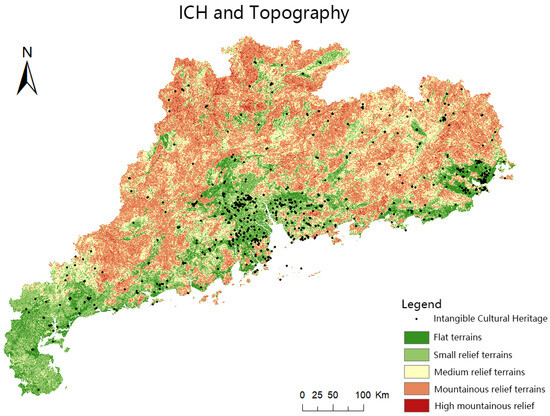
Figure 5.
ICH and topography.
After overlaying, as evidenced by the data patterns in Table 3, the result illustrates that the quantity of ICH items generally decreases as the topographic relief increases. The total amount of ICH items in areas of small relief (2141) far exceeds those in flat (848), medium relief (557), and mountainous relief (30) terrains. This reflects the association between human activities, cultural inheritance, and topographic suitability. Flat and small relief terrains, with their gentle slopes, are conducive to habitation, farming, economic activities, supporting dense populations and frequent exchanges, thereby providing a social foundation for ICH transmission. For instance, traditional craftsmanship, which relies on markets and exchange, shows substantial numbers in flat (379) and small relief (779) terrains. Folk customs, benefiting from the unique regional culture and stable communities in small relief areas, reaches a count of 370 items. Conversely, medium and mountainous relief terrains, with their inconvenient transportation and sparse populations, limit cultural dissemination and exchange. Categories like traditional opera (only one item in mountainous relief) and Quyi (no items), which require substantial audiences and interaction, struggle to thrive in complex mountainous terrains, leading to a sharp decline in their numbers. Terrain influences the formation of ICH by affecting human activities and cultural ecosystems.

Table 3.
Statistics on the number of ICH items by topographic relief category.
4.2. ICH and Rivers
Analysis of the relationship between ICH and major rivers reveals that rivers, as the cradle of human civilization, have profoundly influenced human development. ICH items correspondingly exhibit a characteristic distribution along river systems. Buffer zone analysis was conducted for rivers in Guangdong Province using radii of 2 km, 4 km, 6 km, 8 km, and 10 km, calculating the amount of ICH items within each buffer zone. The results (displayed in Table 4 and Figure 6) present that, overall, the proportion of ICH items within the 0–2 km, 2–4 km, 4–6 km, 6–8 km, and 8–10 km buffer zones account for 24.05%, 19.02%, 11.13%, 6.68%, and 7.44% of the total, respectively. The highest concentration of ICH items (24.05%) is found within the 0–2 km zone from rivers, and the proportion gradually decreases as the distance from the river increases. As the distance exceeds 10 km, the proportion of ICH drops to only 31.66%. Examining different ICH categories, traditional sports, recreation, and acrobatics, folk literature, and Quyi are most densely distributed within the 2–4 km range, but their proportions also gradually decline with increasing distance. River basins are often crucial zones for economic development, which further underscores the close correlation between ICH distribution and socioeconomic development.

Table 4.
The percentage of ICH items within various buffer zones.
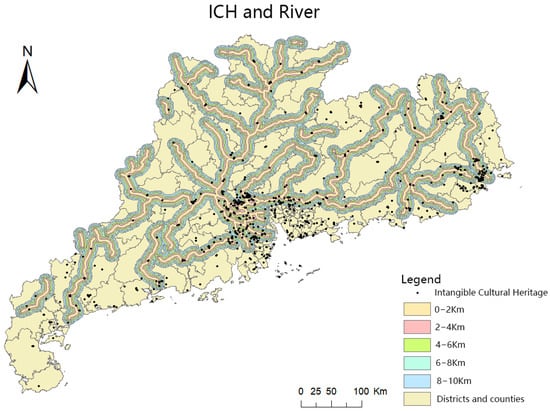
Figure 6.
ICH and rivers.
4.3. ICH and Climate
Climate, as a key factor influencing human production and livelihood, exerts a profound impact on ICH. In Guangdong Province, the distribution of ICH items exhibits notable differences between the tropical monsoon and subtropical monsoon climate zones. Spatially, as shown in Figure 7, most areas of Guangdong belong to the subtropical monsoon climate zone, while the tropical monsoon climate is confined mainly to the coastal region of Zhanjiang. As shown in Table 5, overlay analysis reveals that the subtropical monsoon climate zone demonstrates a much higher ICH density (207 items per 10,000 km2) than the tropical monsoon climate zone (118 items per 10,000 km2), making it the primary concentration area for ICH. Analyzing different categories of ICH reveals that within the tropical monsoon climate zone, only traditional dance and traditional theater exhibit higher densities than in the subtropical monsoon climate zone. Conversely, all other categories demonstrate higher densities in the subtropical monsoon climate zone. For instance, the density of intangible cultural heritage in the traditional craftsmanship category is significantly higher in the subtropical monsoon climate zone (82 items per 10,000 km2) than in the tropical monsoon climate zone (33 items per 10,000 km2). This pattern can be attributed to the moderate temperatures, distinct seasonal variations, and stable agricultural cycles in the subtropical monsoon region, which have fostered population aggregation, commercial prosperity, and cyclical folk activities—thereby providing a sustained environment for ICH transmission. In contrast, the perennial heat and humidity in the tropical monsoon climate zone of Western Guangdong may inhibit collective cultural practices. Coupled with relatively sparse population and weaker economic conditions, these factors contribute to the lower density of ICH in that region.
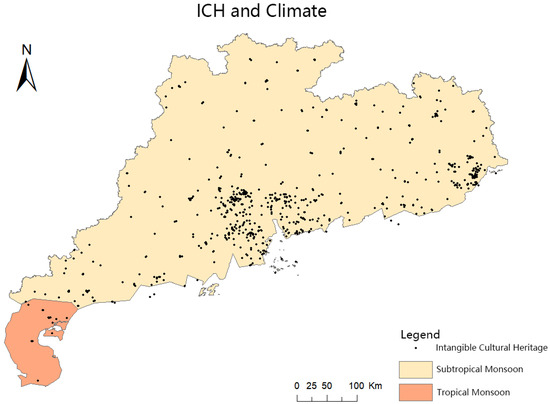
Figure 7.
ICH and climate.

Table 5.
Distribution of ICH items by climate zone.
4.4. ICH and Population
Regional population size both determines the potential audience for ICH transmission and influences the spatial distribution of heritage items. Observing Guangdong’s four major regions reveals two clear population flow trends (Table 6): the PRD has a share of the total population far exceeding its share of year-end registered household population, indicating a strong siphon effect. In contrast, Eastern Guangdong, Western Guangdong, and Northern Guangdong show the opposite pattern, with their share of total population being smaller than their share of year-end registered household population, signaling significant out-migration. This kind of population mobility also influences the distribution of ICH to a certain extent. The PRD exhibits a pattern of “high total population—high year-end registered population—high ICH concentration.” Conversely, Eastern, Western, and Northern Guangdong display a pattern of “low total population—low year-end registered population—low ICH concentration.”

Table 6.
ICH in relation to socioeconomic factors.
Furthermore, the relationship between total population and the number of ICH items shows a “significant inverse correlation”: the PRD has a high proportion of ICH items, but an even higher proportion of the resident population, creating a pattern of “many ICH items, but even more people,” resulting in a lower per capita share. For instance, Shenzhen, with a resident population of 16.438 million, has only 129 ICH items, a per capita share of merely 0.08 items per 10,000 people (illustrated in Figure 8). In contrast, although Eastern, Western, and Northern Guangdong have a lower proportion of ICH items, their resident population share is even lower. For example, Chaozhou in Eastern Guangdong, with a resident population of 2.576 million, possesses 189 ICH items, yielding a per capita ICH ownership of 0.73 items per 10,000 people, the highest in the province.
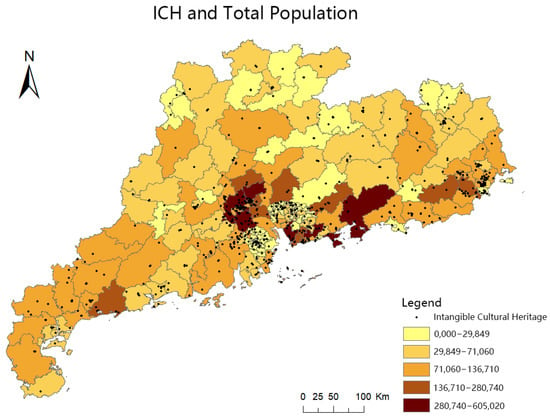
Figure 8.
ICH and population.
In terms of the relationship between year-end registered household population and the number of ICH items, a “positive correlation” is observed (illustrated in Figure 9): regions with a higher share of registered household population often also have a relatively higher share of ICH items. The structure of the registered population demonstrates a more stable and supportive correlation with ICH transmission.
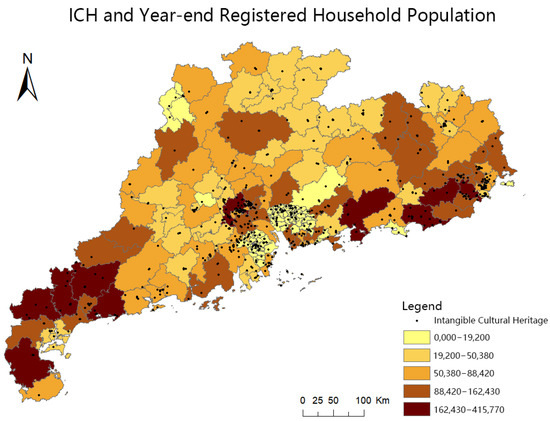
Figure 9.
ICH and year-end registered household population.
4.5. ICH and Economic Development
The economic development influences residents’ lifestyles and quality of life, thereby shaping the spatial distribution pattern of ICH resources. The PRD, with 75.2% of the provincial annual per capita GDP, carries 42.6% of the province’s ICH items, exhibiting the typical characteristic of “high economic output—high ICH share.” Eastern Guangdong, with only 5% of the provincial annual per capita GDP, carries 22.0% of the ICH items; Northern Guangdong, with 11% of the annual per capita GDP, carries 20.6% of the ICH items; and Western Guangdong, with 8% of the annual per capita GDP, carries 14.9% of the ICH items. These three regions all show the typical characteristics of “low economic output—low ICH share,” but also that the “ICH share is higher than the annual per capita GDP share” (Figure 10).
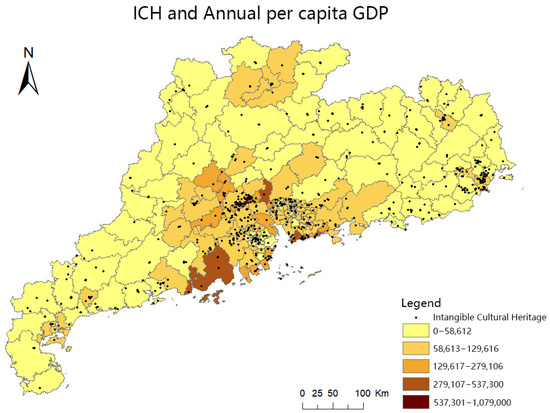
Figure 10.
ICH and annual per capita GDP.
It is noteworthy that while economic level can facilitate the protection and transmission of ICH, it does not directly determine its quantity. For example, Zhongshan has an annual per capita GDP of RMB 137,900 but only 96 ICH items, whereas Shanwei has an annual per capita GDP of RMB 13,400 yet possesses 101 ICH items, presenting a contrast of an “economic depression—cultural repository”.
4.6. ICH and Dialect
Dialect diversity is a core symbol of cultural identity. Spatially, as shown in Figure 11, areas with greater dialect diversity are primarily concentrated in Northern Guangdong, Western Guangdong, and the peripheral areas of the PRD. As a crucial carrier of regional culture, the diversity or stability of a dialect can provide a foundation for ICH transmission. The number of dialects can, to some extent, reflect the cultural depth of a region, thereby influencing the diversity of its ICH. For instance, the average number of dialects per district/county in Yangjiang is 3.33, and in Jiangmen it is 3.29. The high dialect diversity in these two areas corresponds to a higher number of ICH items. This is because, in these regions, diverse dialects reflect the deep integration of fisherman culture and overseas Chinese folklore, providing rich cultural expression scenarios for ICH transmission; thus, the influence of dialect on ICH distribution is relatively significant.
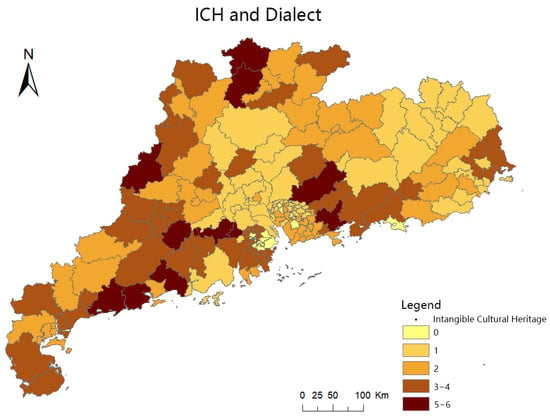
Figure 11.
ICH and dialect.
However, the relationship between the quantity of dialects and the amount of ICH items is not a simple positive correlation. Taking Guangzhou and Foshan as examples, the average number of dialects per district/county is only 1 (predominantly Cantonese), yet, leveraging the profound foundation of Cantonese culture and substantial preservation investment, the number of ICH items is as high as 221. Conversely, although Yunfu has the highest average number of dialects in the province at 3.8, its number of ICH items is only 58, due to factors such as relatively lagging economic development and limited transportation access.
This demonstrates that while dialect diversity can facilitate the diversified development of ICH to some extent, it is not the sole determinant of ICH quantity distribution. The depth of regional cultural heritage, the robustness of transmission and protection mechanisms, and the level of preservation investment also significantly impact the survival, development, and prosperity of ICH.
5. Regression Analysis
To further investigate the natural and socioeconomic factors influencing the distribution of ICH, a regression analysis was conducted by using relevant data from various districts and counties in Guangdong. Based on the preceding analysis, the following explanatory variables were selected (Table 7). Descriptive statistics and collinearity diagnostics were performed on the variables (Table 8). The results of the Poisson regression model analysis are as follows (Table 9):

Table 7.
Description of explanatory variables.

Table 8.
Descriptive statistics of variables.

Table 9.
Poisson regression results.
Regarding natural factors: The degree of terrain relief varies considerably across the districts and counties of Guangdong Province (minimum: 7.93, maximum: 364.21). This indicates complex and diverse topographic conditions, ranging from plains to mountainous areas, which have shaped distinct environments for cultural transmission. The negative impact of topographic barriers indeed exists but is not a decisive force. Regression results show that the terrain relief degree has a non-significant negative impact on the number of ICH items. This is primarily because areas with greater topographic relief often suffer from inconvenient transportation and relatively lagging economic development, which to some extent restricts the dissemination and promotion of ICH. However, it is worth noting that although Northern Guangdong’s mountainous regions suffer from slower economic growth, their ethnic diversity has fostered a rich variety of traditional dance- and music-related ICH. This suggests that while topography may hinder large-scale cultural diffusion, it can also act as a “conservation area” for specific types of ICH. This dual role leads to an overall statistically non-significant effect. Although the coefficient for river length did not reach statistical significance, its positive direction remains noteworthy. As primary transportation routes in ancient times and a key factor in settlement location, rivers provided the essential material foundation and social conditions for the formation of ICH. This implies that regions with longer rivers and denser river networks possess rich water resources. They are conducive to agricultural production and human settlement, thereby providing favorable natural conditions and a social environment for ICH transmission. Annual average temperature has a profound negative impact on the number of ICH items. The result shows high significance in both Model 1 and Model 2, with coefficients remaining stable at approximately −0.06. Combined with descriptive statistics showing a high mean annual temperature (22.57 °C) and a small standard deviation (1.14), it is evident that Guangdong as a whole lies within a relatively high temperature range. Within this range, a moderate increase in temperature may inhibit outdoor activities and collective cultural practices. Excessively high temperatures are unfavorable for human production, life, and various cultural activities, which confirms why the majority of ICH items are distributed in the subtropical monsoon climate zone rather than the high-temperature tropical monsoon climate zone. Although the coefficient for precipitation did not reach statistical significance, it exhibits a positive influence on ICH. This can be attributed to the fact that areas with ample precipitation are more suitable for human labor, habitation, and cultural activities, playing a positive role in ICH transmission.
Regarding social factors: More people equals fewer ICH items. The main reason is that the total population often represents employment-oriented groups characterized by high mobility and strong cultural heterogeneity. Their demand for and identification with local ICH may be limited, thereby diluting the per capita share of ICH items. This manifests statistically as a negative correlation where “a larger population corresponds to relatively fewer items.” In contrast, the year-end registered household population has a profound positive influence on the number of ICH items. After introducing registered population into Model 2, it demonstrated a strongly positive influence (coef = 0.006) with high statistical significance, even partially overshadowing the effect of total population. This robustly confirms that relatively stable local residents possess stronger regional identity and are the main organizers and participants in community rituals and skill apprenticeships. A larger registered population facilitates the continuous reproduction of ICH items, thus showing a significant positive effect.
Concurrently, from the perspective of population migration, the population migration pattern characterized by “the PRD’s siphoning effect and the outflow from Eastern, Western, and Northern Guangdong” significantly influences the spatial differentiation of ICH. Regions with more in-migration exhibit a greater agglomeration effect of ICH items due to the expansion of cultural consumption, the concentration of inheritor populations, and the inclination of relevant policies and resources. Conversely, regions with more out-migration show significantly lower agglomeration of ICH items, primarily due to the loss of prime-age workers and the absence of key inheritors.
The coefficient for GDP per capita is highly significant under both model specifications. Although the coefficient value is small, considering its substantial numerical range (minimum: 12,421; maximum: 1,079,000), its marginal effect on increasing ICH quantity is actually continuous and robust. Regions of greater economic prosperity generally demonstrate heightened public investment from government in the cultural sectors, stronger market incentives provided by enterprises for the innovative transformation of ICH, and higher levels of cultural consumption among residents, thereby furnishing economic support for the inheritance, and promotion of ICH.
The number of dialects shows a significant negative correlation with the quantity of ICH items. Dialect diversity, to some extent, is a product of historical geographical isolation and cultural differentiation. In the modern context, this historically isolated status hinders the external dissemination and contemporary adaptation of culture. Areas with a greater variety of dialects often experience negative impacts on the transmission and dissemination of ICH due to relatively lagging economic development and limited transportation access (e.g., Yunfu). Conversely, areas with fewer dialects (e.g., the Guangzhou–Foshan area), benefit from active economic exchange and smooth cultural communication, and result in a richer number of ICH items.
6. Discussion
Overall, the findings of this study demonstrate a high degree of convergence and continuity with existing research, further validating the general pattern that natural, economic, and social dimensions collectively shape the geographic spread of ICH. In terms of environmental conditions, terrain flatness displays a significant beneficial influence on ICH concentration, whereas regions featured by high altitude and steep slopes—often associated with poor transportation accessibility and low intensity of human activity—tend to correspond with fewer ICH items [,,].
Meanwhile, the “proximity-to-rivers effect” is once again corroborated: rivers not only provide irrigation, navigation, and livelihood diversity but also facilitate population aggregation and cultural convergence, making riparian zones natural incubators for the sustained reproduction of ICH [,,].
Climatically, the temperate monsoon conditions—characterized by moderate humidity, distinct seasonal rhythms, ample precipitation, and suitable temperatures—create an ideal environment for the supply of raw materials used in traditional crafts, the periodic holding of ritual activities, and the daily practices of inheritors. This highlights a strong positive impact on the emergence and sustained transmission of ICH [].
Population density and economic development level exhibit particularly strong explanatory power for the spatial differentiation of ICH: high population density generates scale effects on the demand side and ensures a critical mass of potential inheritors on the supply side, while developed economies—through sound infrastructure, sufficient fiscal investment, and vibrant market transactions—provide sustained momentum for the reproduction and dissemination of ICH [,].
Previous mechanisms identified in ICH spatial distribution research are collectively reflected in Guangdong: for instance, the PRD and Eastern Guangdong, benefiting from flat terrain, dense river networks, mild climate, dense population, and developed economy, have become high-density core areas for most ICH categories such as traditional craftsmanship, traditional fine arts, traditional medicine, and traditional opera. Moreover, cultural diversity accumulated through multi-ethnic distribution has fostered a fertile ground for the derivation, integration, and intergenerational transmission of ICH [].
In Northern Guangdong, for example, despite relatively poor natural conditions and economic backwardness—which hinder the large-scale development of certain ICH categories like traditional craftsmanship—ethnic minority cultures have sustained the local preservation of folk customs ICH. Meanwhile, Western Guangdong has developed distinctive small-scale clusters leveraging marine resources. Based on this, the protection and development of ICH can be planned by considering multiple factors such as cultural heritage and natural endowment as references, thereby formulating targeted development and conservation strategies.
The development and preservation of ICH resources represent a critical task for ICH [,]. Findings from this study indicate that the spatial distribution disparities and their causes are closely linked to natural and social factors. These differences necessitate moving away from a “one-size-fits-all” model of development and preservation towards adopting precise and gradient conservation strategies []. Securing the sustainable future of ICH hinges on creatively fusing its traditional essence with the realities of modern life and contemporary cultural needs [].
Integrating “ICH + Tourism” has evolved into a sustained driver for keeping heritage alive. To safeguard and revitalize ICH dynamically, the clustering and spill-over benefits of both conservation and visitor-oriented activities must be fully harnessed [] by advancing context-sensitive, place-based integration of ICH and tourism as follows:
(1) For regions with significant core agglomeration effects like Guangzhou and Foshan, resources of ICH such as traditional craftsmanship and folk customs can be integrated to create ICH cultural industry clusters combining exhibition, experience, and production. Taking Guangzhou’s very famous Chen Clan Academy (Guangdong Folk Art Museum) as an example, besides being designated a specific ICH protection zone, it could be further expanded into a creative ICH block integrating Cantonese embroidery, Canton porcelain, wood carving displays, traditional handicraft experience courses, and production functions, forming an influential ICH cultural tourism landmark.
(2) In Eastern Guangdong, centered on the core ICH areas of Chaozhou and Shantou, themed around local traditional operas and folk customs, “In-depth Chaozhou-Shantou ICH Cultural Tours” can be designed. This would allow tourists to deeply appreciate the essence of local cultures through experiences like Yingge dance, watching Teochew opera performances, and participating in local Gongfu Tea making ceremonies.
(3) The mountainous Northern Guangdong can focus on ethnic minority culture, hosting ICH performance activities like the Yao people’s long-drum dance and mountain songs, combined with natural landscapes such as Danxia Mountain, enabling tourists to appreciate the beauty of the scenery while experiencing the charm of local ICH culture.
(4) Western Guangdong can leverage its coastal advantages to integrate ICH with tropical coastal tourism. For instance, on Zhanjiang’s Leizhou Peninsula, coastal ICH tourism routes highlighting items like Leizhou Opera and the Human Dragon Dance could be developed, complemented by activities like Maoming’s Nianli Festival (kind of Spring Festival celebrations) and Zhanjiang Seafood Festival, emphasizing the unique identity of regional culture.
Regarding ICH dissemination, active use should be made of new media platforms like live streaming and short-form videos to expose more people to ICH through fragmented, scenario-based storytelling. For ICH items facing the risk of extinction, priority should be given to using digital technologies [] to establish databases of inheritors’ demonstration materials and intensify promotional efforts. Simultaneously, it is imperative to protect the authentic cultural environment upon which ICH depends for survival, avoiding “protective destruction” [] caused by excessive commercial development or misuse of technology.
This study has certain limitations. First, the ICH project data are primarily recorded and stored based on the designated conservation entities at the county/district level, rather than as precise POIs reflecting actual locations. Consequently, multiple entities within the same county/district are counted repeatedly, leading to kernel density estimates that are higher than the actual distribution density of ICH. This approach makes it difficult to reflect spatial variations at micro-scales, such as villages or city blocks. Second, at the variable level, the study failed to effectively quantify specific elements like fiscal cultural expenditures in local policies, as well as infrastructure related to transportation and the cultural tourism industry. Consequently, the true magnitude of these drivers’ influence on where ICH clusters may be understated.
Future research could involve conducting field surveys to disaggregate the county/district-level administrative data into village-level ICH POIs, thereby re-mapping the distribution density and aggregation degree of ICH with greater accuracy. Simultaneously, local contextual factors should be translated into spatially explicit, fine-grained data. This includes quantifying infrastructure flows (e.g., homestays related to ICH, public transport routes, transportation accessibility) and fiscal flows (e.g., specific government budgets allocated for ICH). Such an approach would allow for a more in-depth revelation of the mechanisms influencing the spatial distribution of ICH.
7. Conclusions
The regional variation of ICH stems from the combined influence of regional social conditions and natural factors. Analyzing the spatial distribution characteristics and influencing factors of ICH in Guangdong Province helps to deepen the understanding of the genesis and evolution of regional culture in Guangdong, enhance socio-cultural identity, and consequently unearth excellent traditional Chinese culture, thereby promoting the construction of a regional cultural community. This study introduces GIS spatial analysis methods, such as kernel density and average nearest neighbor analysis, along with Poisson regression analysis, into the research on the influencing mechanisms of ICH spatial distribution. It systematically integrates natural and socioeconomic data of Guangdong Province, filling a gap in the coupling research between “spatial distribution–geographical environment” for ICH in Guangdong. Furthermore, it constructs an analytical framework of “ICH hotspots–influencing mechanisms,” which can better serve the targeted protection of ICH and cultural construction in Guangdong Province. The principal findings are summarized as follows:
(1) The spatial configuration of ICH in Guangdong Province is extensive, but there are large quantitative disparities between categories and significant regional categories variations. Macroscopically, the PRD has the most ICH items, accounting for 42.37%, followed by Eastern Guangdong, Western Guangdong, and Northern Guangdong at 22.18%, 15.13%, and 20.33%, respectively. The distribution also exhibits significant clustering, forming a high-density cluster in the PRD centered on the Guangzhou–Foshan area and another in Eastern Guangdong centered on the Chaozhou–Shantou area.
(2) The spatial distribution characteristics of high-density clusters vary across different categories of ICH, showing different degrees of agglomeration patterns. Specifically: Traditional Fine Arts exhibit the strongest agglomeration; Traditional Craftsmanship, Folk Customs, Traditional Music, show a secondary level of agglomeration; Traditional Dance exhibits the weakest agglomeration.
(3) The geographic pattern of ICH is tightly coupled with natural and socioeconomic drivers. In terms of topography, high-density and relatively dense ICH zones are mostly located in flat and small relief terrain. However, some physically “enclosed” topographic areas, such as the mountainous Northern Guangdong, also possess a considerable number of ICH items. Specifically, the proportions of traditional dance, traditional music, folk literature, and folk customs items in Northern Guangdong, while lower than those in the PRD, are higher than those in the coastal Eastern and Western Guangdong regions. ICH items also tend to be distributed near rivers, with 68.32% of ICH items located within a 10 km buffer zone of Chinese rivers. Climatically, the subtropical monsoon zone has a higher density of ICH distribution, while the tropical monsoon zone has the lowest density. Ample precipitation and moderate temperatures are conducive to the formation of ICH. Total population has a negative impact on ICH due to its high mobility and cultural heterogeneity, whereas the year-end registered population has a positive impact due to its stability and strong local identity. A positive association exists between annual per capita GDP and the count of heritage items, signaling that stronger economic performance nurtures the growth of intangible culture. Areas with a greater number of dialects are often located in places with relatively poor transportation access and underdeveloped economies, which is unfavorable for ICH development.
Author Contributions
Conceptualization, C.Z. and Y.Z.; methodology, C.Z.; software, C.Z. and W.W.; validation, L.X. and Y.Z.; formal analysis, C.Z.; investigation, Y.Z.; resources, L.X.; data curation, Y.Z. and W.W.; writing—original draft preparation, C.Z.; writing—review and editing, Y.Z.; visualization, W.W.; supervision, L.X.; project administration, C.Z. and L.X.; funding acquisition, Y.Z. and C.Z. All authors have read and agreed to the published version of the manuscript.
Funding
This research was funded by the Ministry of Education of the People’s Republic of China (Grant No. 22YJA760005); Department of Education of Guangdong Province (Grant No. 2024WCXTD044); Guangzhou Research Base for Collaborative Cultivation of High-Level Technical and Skilled Talents; 2024 Guangdong Higher Education Key Areas Special Project (Grant No.2024ZDZX4110); Philosophy and Social Science Planning Program of Guangdong Province (Grant No. GD24XYJ27); Guangzhou Panyu Polytechnic (Grant No. 2021KJ21).
Institutional Review Board Statement
Not applicable.
Informed Consent Statement
Not applicable.
Data Availability Statement
The datasets used and analyzed during the current study are available from the corresponding author upon reasonable request.
Conflicts of Interest
The authors declare no conflicts of interest.
Abbreviations
The following abbreviations are used in this manuscript:
| ICH | Intangible Culture Heritage |
| PRD | Pearl River Delta |
References
- Li, J.; Wang, Z. Spatial distribution and pedigree age of national intangible cultural heritage. Acta Geogr. Sin. 2022, 77, 3162–3179. [Google Scholar]
- Interim Measures for the Application and Evaluation of Representative Works of National Intangible Cultural Heritage; General Office of the State Council of the People’s Republic of China: Beijing, China, 2005. Available online: https://www.gov.cn/gongbao/content/2005/content_63227.htm (accessed on 12 November 2024).
- UNESCO. Text of the Convention for the Safeguarding of the Intangible Cultural Heritage. Available online: https://ich.unesco.org/en/convention (accessed on 2 November 2025).
- Notice of the Ministry of Culture and Tourism on Issuing the 14th Five-Year Plan for the Protection of Intangible Cultural Heritage; The Ministry of Culture and Tourism: Beijing, China, 2021. Available online: https://www.gov.cn/zhengce/zhengceku/2021-06/09/content_5616511.htm (accessed on 10 October 2025).
- Keitumetse, S. UNESCO 2003 convention on intangible heritage: Practical implications for heritage management approaches in Africa. S. Afr. Archaeol. Bull. 2006, 61, 166–171. [Google Scholar] [CrossRef]
- Wulf, C. Immaterielles Kulturelles Erbe. Aktuelle Entwicklungen und Grundlegende Strukturelemente. Die Tonkunst. 2016, 10, 371–377. [Google Scholar]
- Menzel, S. Musik als Immaterielles Kulturerbe—Musik als Kulturelles Gedächtnis. Die Tonkunst. 2016, 10, 390–396. [Google Scholar]
- de Oliveira Pinto, T. Musik als Kultur. Eine Standortsuche im immateriellen Kulturerbe. Die Tonkunst. 2016, 10, 378–389. [Google Scholar]
- Li, Q. National Intangible Cultural Heritage of the Yellow River Basin Spatial Distribution Characteristics and Influencing Factors. Master’s Thesis, Shanxi Normal University, Taiyuan, China, 25 May 2023. [Google Scholar]
- Thomas, M.S. The UNESCO concept of safeguarding intangible cultural heritage: Its background and Marrakchi roots. Int. J. Herit. Stud. 2008, 14, 95–111. [Google Scholar]
- Wang, J.; Chen, M.; Zhang, H.; Ye, F. Intangible cultural heritage in the Yangtze River basin: Its spatial distribution characteristics and influencing factors. Sustainability 2023, 15, 7960. [Google Scholar] [CrossRef]
- Li, J. Productive protection of intangible cultural heritage and development of derivative products: A discussion based on inheritance and dissemination. Sichuan Opera 2019, 11, 93–96. [Google Scholar]
- Zhou, C.; Zhou, L.; Zhang, X.H. Spatial differentiation and driving factors of multi-category intangible cultural heritages in China. Geogr. Geo-Inf. Sci. 2023, 39, 72–80. [Google Scholar]
- Hu, J.; Chen, M.L.; Zhang, Y.Q.; Gong, Y.J.; Kong, Y.R. Spatial-temporal distribution characteristics of the intangible cultural heritage in Hubei province. Econ. Geogr. 2017, 37, 206–214. [Google Scholar]
- Li, R.; Shi, Z. Spatial relationship and formation mechanism of traditional villages and intangible cultural heritage in the Yellow River Basin. Econ. Geogr. 2022, 42, 205–212. [Google Scholar]
- Zhang, Z.; Wang, Z.; Lin, B.; Cheng, X. Spatial distribution characteristics and influencing factors of national intangible culture heritage in China. Resour. Dev. Mark. 2023, 39, 949–956. [Google Scholar]
- Jiao, M.; Lu, L. Spatial differentiation characteristics of the national-level intangible cultural heritage items of food and their influencing factors. J. Chin. Ecotourism 2024, 14, 544–559. [Google Scholar]
- He, Y.; Shi, X.; Zeng, B.; Wang, J. Spatial distribution characteristics and influencing factors of intangible cultural heritage in Southwest China. J. Zhejiang Univ. (Sci. Ed.) 2023, 50, 628–638+650. [Google Scholar]
- Nie, X.; Xie, Y.; Xie, X.; Zheng, L. The characteristics and influencing factors of the spatial distribution of intangible cultural heritage in the Yellow River Basin of China. Herit. Sci. 2022, 10, 121. [Google Scholar] [CrossRef]
- Yan, H.; Wang, Y.; Xiong, H.; Zhang, X. Research on spatial distribution characteristics and influencing factors of national folk intangible cultural heritage. J. Northwest Norm. Univ. (Nat. Sci.) 2021, 57, 101–109. [Google Scholar]
- Mu, S.; Yuan, Z.; Wuritaoketaohu. Spatial differentiation pattern and impacting mechanism of intangible cultural heritages in the Yellow River Basin. J. Desert Res. 2022, 42, 255–265. [Google Scholar]
- Jiao, N. Evaluation of the coordination degree and influencing factors of intangible cultural heritage and the tourism industry: A case study of Shandong province. Soc. Sci. 2022, 11, 49–57. [Google Scholar]
- Cheng, Q.; Ling, S. Geographical distribution and affecting factors of the intangible cultural heritage in China. Geogr. Sci. 2013, 33, 1166–1172. [Google Scholar]
- Zhang, Z.; Li, Q.; Hu, S. Intangible cultural heritage in the Yellow River Basin: Its spatial–temporal distribution characteristics and differentiation causes. Sustainability 2022, 14, 11073. [Google Scholar] [CrossRef]
- Shi, Y. The spatial distribution and protection strategies of intangible cultural heritage in the Yangtze River Economic Belt. Nanjing J. Soc. Sci. 2023, 10, 152–160. [Google Scholar]
- Jiang, J.; Yang, Q.; Zhang, Z.; Su, K. Spatial distribution pattern of intangible cultural heritage and tourism development in Chongqing. Econ. Geogr. 2019, 39, 205–213. [Google Scholar]
- Zhang, G.; Yuan, H. Distribution characteristics and scenic response mechanism of intangible cultural heritage resources: Based on network text information mining and quantitative measure analysis. Areal Res. Dev. 2023, 42, 102–107. [Google Scholar]
- Yuan, S.; Chen, B. Structure and geographical distribution of the intangible cultural heritage in Guangdong. Trop. Geogr. 2012, 32, 94–97. [Google Scholar]
- C.I.C.H. Directory of Representative Items of National Intangible Cultural Heritage. Available online: https://www.ihchina.cn/project#target1 (accessed on 15 October 2025).
- Guangdong Culture Center. Directory of Representative Items of Provincial Intangible Cultural Heritage of Guangdong Province. Available online: http://www.gdsqyg.com/agdfyzg/minglu (accessed on 5 October 2025).
- People’s Government of Guangdong Province. Directory of Representative Items of County/District-Level Intangible Cultural Heritage. Available online: http://www.gd.gov.cn (accessed on 15 November 2024).
- Zhang, Z.; Cui, Z.; Fan, T.; Ruan, S.; Wu, J. Spatial distribution of intangible cultural heritage resources in China and its influencing factors. Sci. Rep. 2024, 14, 4960. [Google Scholar] [CrossRef]
- Resource and Environmental Science Data Platform. Provincial DEM 90m Data (SRTM 90 m). Available online: https://www.resdc.cn (accessed on 3 October 2025).
- Guangdong Provincial Archives Database. 2023 Yearbooks of the Districts and Counties in Guangdong Province. Available online: https://dfz.gd.gov.cn/dfz/html/gdsqsj/sxnj/pc/page1.shtml#/ (accessed on 5 October 2025).
- Yu, W.; Ai, T.; Shao, S. The analysis and delimitation of Central Business District using network kernel density estimation. J. Transp. Geogr. 2015, 45, 32–47. [Google Scholar] [CrossRef]
- Liu, L.; Zhang, C.; Feng, J.; Xiao, L.; He, Z.; Zhou, S. The spatial-temporal distribution and influencing factors of fraud crime in ZG city, China. Acta Geogr. Sin. 2017, 72, 315–328. [Google Scholar]
- Wang, F. Quantitative Methods and Applications in GIS, 1st ed.; The Commercial Press: Beijing, China, 2009. [Google Scholar]
- Cheng, L.; Wang, F.; Xiu, C. Spatial analysis of bank branches and its relationship to popu-economic activities: A case study in Changchun central urban area. Hum. Geogr. 2015, 30, 72–78. [Google Scholar]
- Li, J.; Zhao, Q.; Chen, J. Spatial distribution characteristics and influencing factors of intangible cultural heritage in Yangtze River Economic Belt. Econ. Geogr. 2020, 40, 191–198. [Google Scholar]
- Yang, R.; Deng, Y. The evolution and optimized reconstructing analysis of rural settlement system in Guangdong province. Acta Geogr. Sin. 2024, 79, 281–298. [Google Scholar]
- Yang, J.; Wang, L.; Wei, S. Spatial variation and its local influencing factors of intangible cultural heritage development along the Grand Canal in China. Int. J. Environ. Res. Public Health 2023, 20, 662. [Google Scholar] [CrossRef]
- Hu, Q.; Yang, P.; Ma, J.; Wang, M.; He, X. The spatial differentiation characteristics and influencing mechanisms of intangible cultural heritage in China. Heliyon 2024, 10, e38689. [Google Scholar] [CrossRef]
- Zhang, X.; Xiang, H.; Liu, R. Spatial pattern and influencing factors of intangible cultural heritage of music in Xiangxi, central China. Herit. Sci. 2022, 10, 39. [Google Scholar] [CrossRef]
- Han, Q.; Tao, F.; Hong, Z.; Qin, G.; Wei, Y.; Chen, Y.; Zhou, T. Research on the spatiotemporal distribution and factors influencing intangible cultural heritage in Fujian Province from a multiscale perspective. Herit. Sci. 2024, 12, 239. [Google Scholar] [CrossRef]
- Meng, L.; Yan, F.; Fang, Q.; Si, W. Research on the educational tourism development of intangible cultural heritage: Suitability, spatial pattern, and obstacle factor. Sustainability 2024, 16, 4647. [Google Scholar] [CrossRef]
- Liu, Y.; Chen, M.; Tian, Y. Temporal and spatial patterns and influencing factors of intangible cultural heritage: Ancient Qin-Shu roads, Western China. Herit. Sci. 2022, 10, 201. [Google Scholar] [CrossRef]
- Zou, L.; Tai, P.; Wang, X.; Jiao, J.; Wang, Y. Study on the spatial and temporal differentiation of intangible cultural heritage and its influencing factors in Shandong province. Sci. Rep. 2025, 15, 24792. [Google Scholar] [CrossRef]
- Dong, B.; Bai, K.; Sun, X.; Wang, M.; Liu, Y. Spatial distribution and tourism competition of intangible cultural heritage: Take Guizhou, China as an example. Herit. Sci. 2023, 11, 64. [Google Scholar] [CrossRef]
- Li, C.; Qian, Y.; Li, Z.; Tong, T. Identifying factors influencing the spatial distribution of minority cultural heritage in Southwest China. Herit. Sci. 2024, 12, 117. [Google Scholar] [CrossRef]
- Yang, L. Analysis of digital rescuing conservation including rescuing notes and oral history for representative successors of intangible heritage in information age. Stud. Cult. Art 2017, 02, 36–41. [Google Scholar]
- Yuan, Q. Research on the digital preservation and development of China’s intangible cultural heritage. Cult. Ind. 2021, 35, 88–90. [Google Scholar]
Disclaimer/Publisher’s Note: The statements, opinions and data contained in all publications are solely those of the individual author(s) and contributor(s) and not of MDPI and/or the editor(s). MDPI and/or the editor(s) disclaim responsibility for any injury to people or property resulting from any ideas, methods, instructions or products referred to in the content. |
© 2025 by the authors. Licensee MDPI, Basel, Switzerland. This article is an open access article distributed under the terms and conditions of the Creative Commons Attribution (CC BY) license (https://creativecommons.org/licenses/by/4.0/).